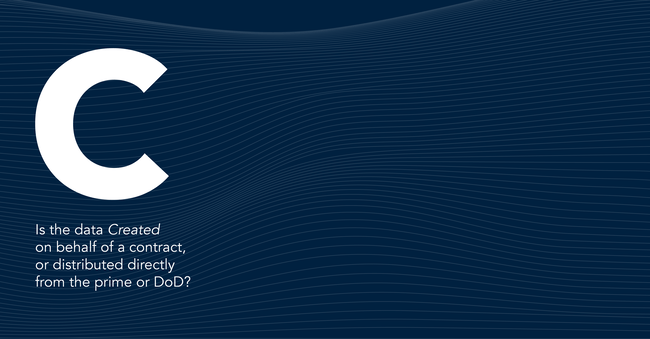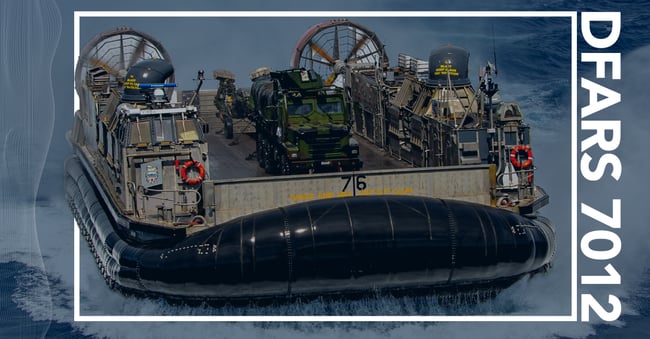Is Google Workspace CMMC, DFARS, and ITAR Compliant?
This blog covers if Google Workspace is CMMC, DFARS, and ITAR compliant for contractors in the Defense Industrial Base looking to leverage the platform.
Yes - Google Workspace is CMMC compliant. However, you'll need to seriously evaluate the many caveats and one-off implementations that the platform requires to meet current compliance requirements.
Within the defense supply chain, contracts are filled with clauses that mandate the implementation of minimum-security baselines to protect different data types - Defense Federal Acquisition Regulation Supplement (DFARS) 7012, 7019, 7020, 7021, and CMMC requirements. As a result, DoD contractors are searching for cloud service offerings that can provide productivity and collaboration without compromising the ability to meet regulatory obligations. Unfortunately, many providers and potential customers find that achieving these goals is easier said than done.
Google Workspace may seem cheaper and easier, but because it lacks native functions like Microsoft has, and therefore requires third-party tools, it actually ends up being more expensive and convoluted than Microsoft, which is the platform purpose-built and trusted by the DoD.
Related blog: Google Workspace vs Microsoft 365 for Government Contractors: Which Is Better?
In this blog, we'll discuss the following commonly asked questions:
- Is Google Workspace CMMC/NIST compliant?
- Is Google Workspace DFARS compliant?
- Is Google Workspace ITAR compliant?
- What are the limitations of Google Workspace for DoD Contractors?
- Should you use Google for CMMC?
Google Workspace and Compliance
Google workspace’s ability to satisfy the requirements of NIST SP 800-171 and CMMC was evaluated by a Certified 3rd Party Assessment Organization (C3PAO). As a result of that assessment, Google Workspace was awarded a letter of attestation by the C3PAO which documented the platform's ability to satisfy NIST 800-171 and CMMC requirements.
Additionally, in July 2022, Google Workspace announced that it earned a DoD Impact Level 4 (IL4) authorization. For organizations to inherit the shared responsibility benefits of the Workspace’s IL4 authorization, they would need to deploy Google’s Assured Workloads. Without this product deployed, the organization’s Google Workspace environment is only a DoD IL2 environment.
Let's discuss how this impacts DoD contractors that handle CUI / ITAR (export-controlled data). In this section, we will use the results of the IL4 authorization and the NIST 800-171 letter of attestation to analyze Google Workspace's capability to satisfy:
- The requirements of CMMC 2.0 / NIST 800-171
- DFARS 7012 requirements
- International Traffic in Arms Regulations (ITAR) and Export Administration Regulations (EAR) restrictions
Is Google Workspace CMMC/NIST compliant?
The 3PAO letter of attestation called out findings with four of the CMMC / NIST 800-171 cybersecurity practices:
- CMMC AC.L2-3.1.9 / NIST 3.1.9 – Provide privacy and security notices consistent with applicable CUI rules.
- Google Workspace is actually incapable of displaying notices at user login, making it incapable of meeting CMMC AC.L2-3.1.9 / NIST 3.1.9. The organization would have to find a compatible and compliant 3rd party technology in order to successfully implement this control.
- Google Workspace is actually incapable of displaying notices at user login, making it incapable of meeting CMMC AC.L2-3.1.9 / NIST 3.1.9. The organization would have to find a compatible and compliant 3rd party technology in order to successfully implement this control.
- CMMC IA.L2-3.5.6/ NIST 3.5.6 - Disable identifiers after a defined period of inactivity.
- Workspace would require the organization to put manual processes in place to disable identifiers inactive outside of the organization's determined limits. Both controls can be fulfilled by the organization but not automated through the capabilities within Google Workspace.
- Workspace would require the organization to put manual processes in place to disable identifiers inactive outside of the organization's determined limits. Both controls can be fulfilled by the organization but not automated through the capabilities within Google Workspace.
- CMMC IA.L2- 3.5.7 / NIST 3.5.7 - Enforce a minimum password complexity and change of characters with new passwords are created.
- CMMC IA.L2- 3.5.8 / NIST 3.5.8 – Prohibit password reuse for a specified number of generations.
Contrary to the findings of the NIST 800-171 attestation letter, Google Workspace can meet both CMMC IA.L2- 3.5.7 / NIST 3.5.7 and CMMC IA.L2- 3.5.8 / NIST 3.5.8. Admins in Google Workspace are capable of enforcing and monitoring password requirements for all users. The list of custom configuration capabilities includes things like password length, strength, and period allowed for re-usage. Because of this, the admin can configure the password policy in Workspace to mimic their organizationally defined password values to meet help them satisfy both of the controls listed above.
Ultimately, satisfying CMMC / NIST 800-171 requirements with Google Workspace is possible but depends on the organization's ability to compensate for the identified control deficiencies in CMMC AC.L2-3.1.9 / NIST 3.1.9 and CMMC IA.L2-3.5.6/ NIST 3.5.6.

Does Google Workspace meet DFARS Requirements?
Paragraphs b-g of DFARS 252.204-7012 include requirements for organizations regarding their information system and the cloud services they use. For example, paragraph b requires DIB organizations to successfully ensure that adequate security is applied to their information system and cloud services, with adequate security being defined as the implementation of NIST 800-171, and cloud services require a FedRAMP moderate authorization or equivalent.
As was discovered when evaluating the CMMC / NIST 800-171 capabilities of Google Workspace, organizations choosing Google Workspace DFARS compliance have some work to do to achieve compliance. Because Google Workspace is authorized to the FedRAMP HIGH baseline, it also meets the cloud services security requirements of DFARS 7012.
However, this is the only paragraph of the clause which Google Workspace can meet without the deployment of Google Assured Workloads. Without assured workloads deployed, the organization does not inherit the control implementations found in the IL4 authorization, many of which allow Workspace to satisfy the incident response, incident reporting, malicious software, media preservation, and forensic analysis requirements found in paragraphs c-g of the DFARS 7012 clause.
Is Google Workspace ITAR compliant?
Prior to December 26, 2019, Google advised against organizations with ITAR data using their platform because of their business model and staffing. There was no assurance that the data would be stored strictly on U.S soil or that the data would only be accessed by cleared U.S. Citizens (both requirements of export-controlled data). The rules changed a little bit on December 26, 2019, and so did the Google Workspace capabilities. A published interim final rule by the Directorate of Defense Trade Controls (DDTC) amended the International Traffic in Arms Regulations (ITAR) requirements to harmonize with the Export Administration Regulations (EAR). This rule would create ITAR section 120.54 to largely mirror EAR section 734.18, which defines activities that are not exported, re-export, or retransferred. This interim rule made the "ITAR Carve out", giving organizations more flexibility with ITAR requirements, allowing Google Workspace to be ITAR compliant and capable, with extra help.
As a result, Google workspace can be leveraged by organizations to meet ITAR requirements if:
- Google Client-side encryption (CSE) or another 3rd party CSE solution is leveraged to encrypt the data at the client host
- Google Cloud Key management or another 3rd party key management solution is implemented and controlled only by the organization or authorized proxies (MSP/MSSP, etc.)
AND
- The organization leverages the security and capabilities of the Google Assured Workload product -including performing actions such as dictating their data storage locations.
This approach to export-controlled restrictions has quite a few caveats, but it is achievable for DIB contractors. It comes with a more significant workload and more opportunities for mistakes than M365 GCC High.
.gif?width=1000&height=563&name=giphy%20(11).gif)
What are the Limitations of Google Workspace for DoD Contractors?
Google Workspace does not provide a built-in, government-specific cloud environment that meets the security and data protection standards required for DoD contractors. Unlike Microsoft 365 GCC High, which is designed to meet DFARS, CMMC, and ITAR compliance within a controlled infrastructure, Google Workspace requires multiple third-party tools to address compliance gaps. This increases operational complexity, cost, and the risk of misconfigurations that could lead to compliance failures.
No Dedicated Government Cloud
Microsoft offers M365 GCC and GCC High environments to ensure government contractors operate within a secure, compliance-focused infrastructure. Google Workspace lacks a comparable environment, forcing contractors to manage data sovereignty and access controls externally. Meeting ITAR’s data residency and export control requirements is significantly more challenging without a sovereign cloud enclave.
Deficient Native Security and Compliance Controls
Meeting compliance mandates requires a platform with built-in security controls. Microsoft 365 GCC High includes Defender for Endpoint, Security Center, Purview for compliance management, and Azure Arc for secure system monitoring. Google Workspace does not offer these capabilities natively. Contractors relying on Google must integrate third-party tools like CrowdStrike for endpoint detection, Palo Alto XSOAR for incident response, and Netskope for CASB functions. Each additional tool increases overhead, complicates system management, and introduces new security risks.

Lack of Endpoint Protection and Incident Response Tools
Contractors handling CUI must ensure endpoint security, continuous monitoring, and rapid incident response capabilities. Microsoft 365 GCC High includes Microsoft Defender for Endpoint, providing real-time threat detection, automated incident response, and forensic investigation tools. Google Workspace requires external solutions for these functions, increasing the administrative burden and costs associated with maintaining a secure environment.

Should You Use Google Workspace for CMMC?
Organizations subject to CMMC Level 2 and above will encounter significant challenges in achieving compliance using Google Workspace. The platform lacks the necessary infrastructure, security tools, and compliance alignment that Microsoft 365 GCC High provides natively. Attempting to meet compliance requirements with Google requires layering multiple external security solutions, leading to higher costs, operational inefficiencies, and increased risk of misconfigurations.
Cost and Risk Increases Due to Third-Party Dependencies
The cost of Google Workspace Enterprise Plus does not include endpoint protection, advanced auditing, or incident response tools. To close these security gaps, contractors must purchase and manage multiple third-party applications, driving total costs higher than Microsoft 365 GCC High. With M365 GCC HIgh, data is encrypted, stored, and processed within Microsoft’s controlled, U.S.-based cloud environments, helping organizations meet many NIST SP 800-171 standards without additional configuration.

Conclusion
DoD contractors requiring CMMC, DFARS, and ITAR compliance should use a platform that inherently meets government security and compliance expectations. Google Workspace is not designed for government compliance at scale. While it may appear cost-effective initially, the need for additional security tools, external compliance management, and manual security configurations ultimately make it more expensive and less efficient than Microsoft 365 GCC High. Contractors should choose a solution that provides integrated security, streamlined compliance management, and a controlled government cloud environment.
Want to learn more about Microsoft 365 GCC High for CMMC? Start here.





